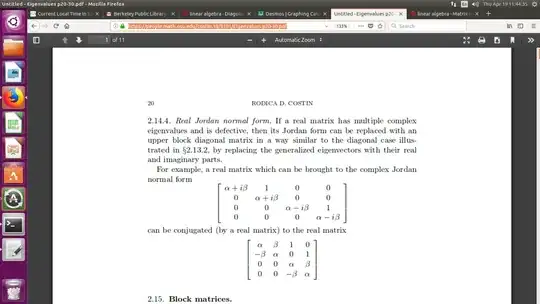I finished this, I think I will revise it to agree with the example in Costin, which is the only image i could find so far that showed what I wanted. First we find the Jordan form with the complex eigenvalues; this involves generalized eigenvectors here. Next, for the two vectors for a fixed eigenvalue (here $i$) for each make a pair of real vectors out of the real and imaginary parts. Just needs care. I need to get groceries and will typeset things later, that will take some real time. Notes at COSTIN

Here is the Jordan form $J$ and how to get there as $P^{-1}A P = J$
$$
\frac{1}{8}
\left(
\begin{array}{cccc}
1&i&0&0 \\
0&0&-4i&4 \\
-i&-1&0&0 \\
0&0&4&-4i \\
\end{array}
\right)
\left(
\begin{array}{cccc}
0&-1&0&4 \\
1&0&-4&0 \\
0&0&0&-1 \\
0&0&1&0 \\
\end{array}
\right)
\left(
\begin{array}{cccc}
4&0&4i&0 \\
-4i&0&-4&0 \\
0&i&0&1 \\
0&1&0&i \\
\end{array}
\right) =
\left(
\begin{array}{cccc}
i&1&0&0 \\
0&i&0&0 \\
0&0&-i&1 \\
0&0&0&-i \\
\end{array}
\right)
$$
Give me a bit more time, real part next. All we do is take the real and imaginary parts of the (generalized) eigenvectors that gave eigenvalue $i$ in getting $J,$ these being the first two columns on the left.
$$
\frac{1}{4}
\left(
\begin{array}{cccc}
1&0&0&0 \\
0&-1&0&0 \\
0&0&0&4 \\
0&0&4&0 \\
\end{array}
\right)
\left(
\begin{array}{cccc}
0&-1&0&4 \\
1&0&-4&0 \\
0&0&0&-1 \\
0&0&1&0 \\
\end{array}
\right)
\left(
\begin{array}{cccc}
4&0&0&0 \\
0&-4&0&0 \\
0&0&0&1 \\
0&0&1&0 \\
\end{array}
\right) =
\left(
\begin{array}{cccc}
0&1&1&0 \\
-1&0&0&1 \\
0&0&0&1 \\
0&0&-1&0 \\
\end{array}
\right)
$$
